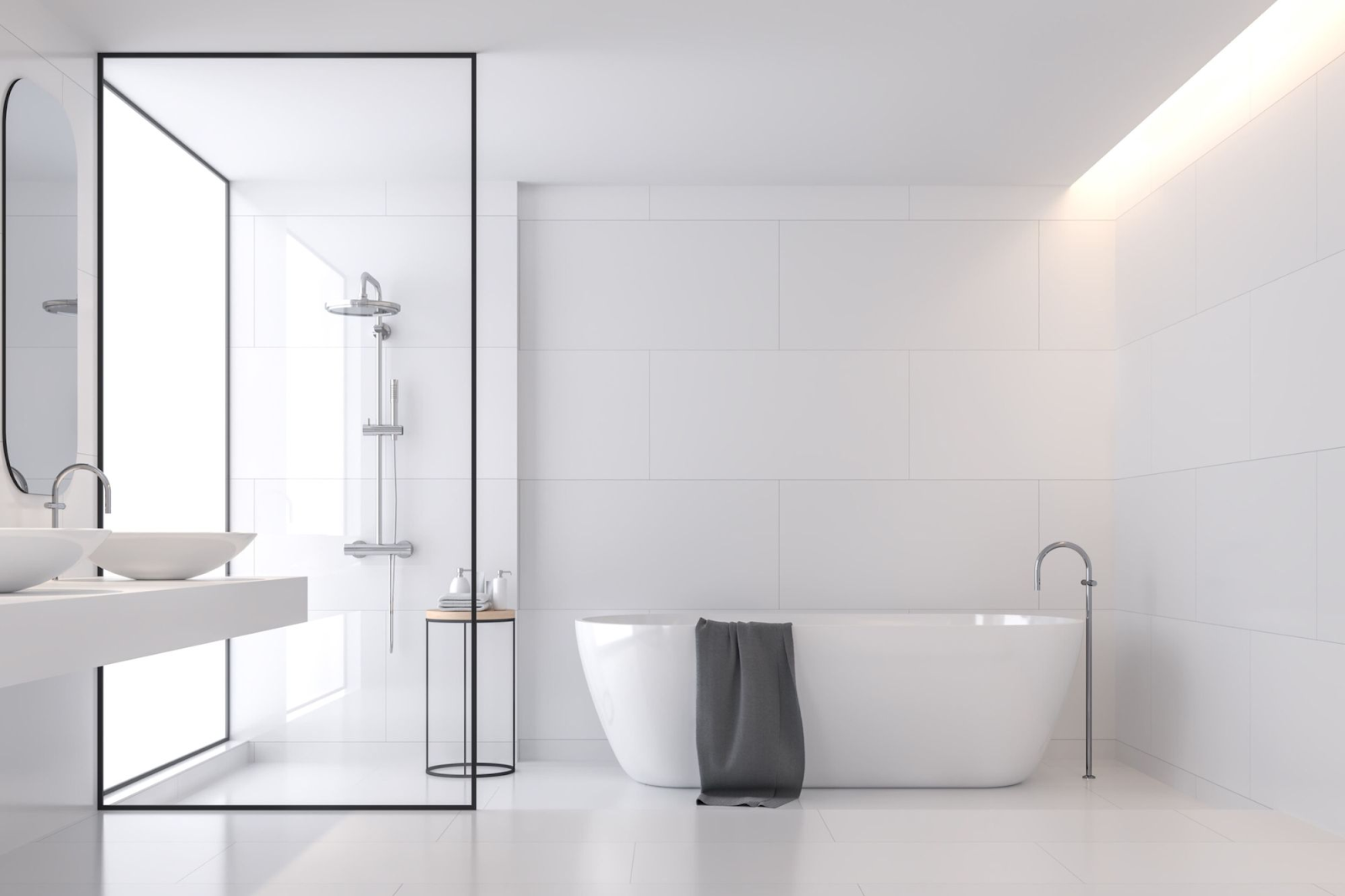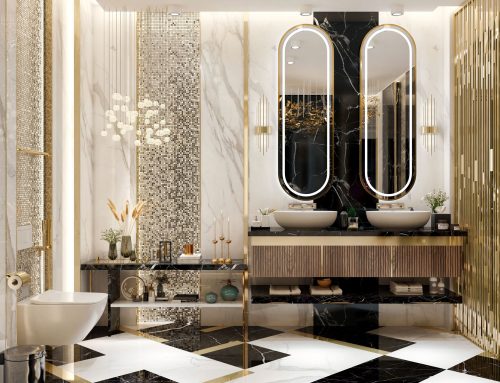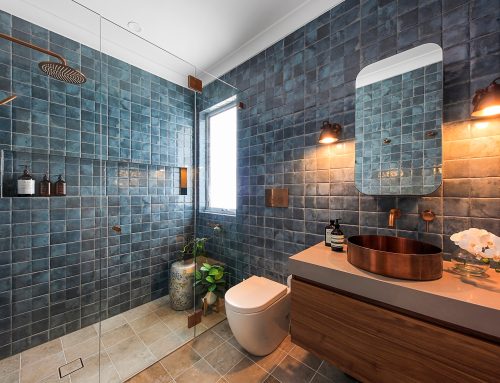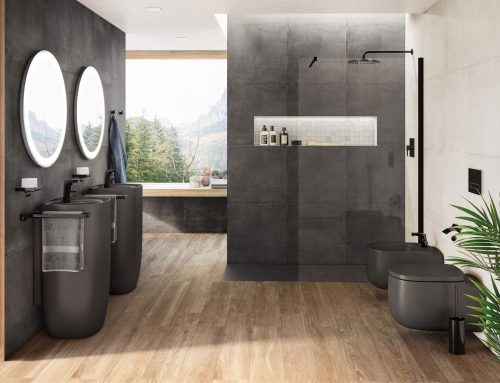Modern minimalism in bathroom design is all about creating a serene, uncluttered, and functional space. This style emphasizes clean lines, simple color schemes, and an overall sense of calm and order. By focusing on functionality and stripping away unnecessary elements, a minimalist bathroom can become a sanctuary where one can escape the chaos of everyday life. This article will delve into the principles of modern minimalism, explore various design elements, and provide practical tips for achieving this aesthetic in your bathroom.
The Principles of Modern Minimalism
Modern minimalism is guided by a few key principles that help create a cohesive and tranquil space. Understanding these principles is the first step towards designing a minimalist bathroom.
- Simplicity: Simplicity is the cornerstone of minimalism. This means using a restrained color palette, choosing furniture and fixtures with clean lines, and avoiding overly ornate details. The goal is to create a space that feels open and uncluttered.
- Functionality: In a minimalist bathroom, every element should serve a purpose. This focus on functionality means that decorative items are kept to a minimum, and storage solutions are carefully considered to keep surfaces clear and organized.
- Clean Lines: Clean, straight lines are a hallmark of modern minimalist design. This applies to everything from the architecture of the space to the design of the fixtures and fittings. Avoiding curves and ornate details helps maintain a sense of order and simplicity.
- Open Space: Creating a sense of open space is essential in minimalist design. This can be achieved by choosing a layout that maximizes floor space, using light colors to make the room feel larger, and incorporating large windows or mirrors to enhance the sense of openness.
- Natural Light: Natural light is an important element in minimalist design. It enhances the feeling of openness and brings a sense of calm to the space. Maximizing natural light through large windows, skylights, or strategically placed mirrors can make a significant difference in a minimalist bathroom.
- Quality Over Quantity: Minimalism places a strong emphasis on quality over quantity. This means choosing high-quality materials and fixtures that will stand the test of time, rather than filling the space with numerous decorative items. The focus is on creating a space that is both beautiful and durable.
Designing a Minimalist Bathroom
Designing a minimalist bathroom involves careful planning and consideration of various elements. From the layout and color scheme to the fixtures and storage solutions, each aspect plays a crucial role in achieving a cohesive and functional space.
Layout
The layout of a minimalist bathroom should prioritize open space and easy movement. Here are some tips for creating an effective layout:
- Maximize Floor Space: Choose a layout that minimizes obstacles and maximizes floor space. This can be achieved by using wall-mounted fixtures, such as toilets and sinks, and opting for a walk-in shower instead of a bathtub.
- Create Zones: Divide the bathroom into functional zones, such as the shower area, toilet area, and vanity area. This helps maintain a sense of order and makes the space more functional.
- Use Built-In Storage: Incorporate built-in storage solutions, such as recessed shelves or cabinetry, to keep the space organized and free of clutter.
- Keep It Simple: Avoid overly complex layouts and stick to simple, straightforward designs. This enhances the sense of calm and order in the space.
Color Scheme
The color scheme of a minimalist bathroom should be simple and cohesive. Here are some tips for choosing the right colors:
- Stick to Neutrals: Neutral colors, such as white, gray, and beige, are ideal for a minimalist bathroom. These colors create a sense of calm and make the space feel larger and more open.
- Add Subtle Contrasts: While the overall color scheme should be simple, adding subtle contrasts can create visual interest. For example, you could use different shades of the same color or incorporate natural materials, such as wood or stone, to add texture.
- Use Color Sparingly: If you want to incorporate color, use it sparingly and choose muted, understated shades. Avoid bold or bright colors, which can disrupt the sense of calm in a minimalist bathroom.
- Embrace Monochrome: A monochrome color scheme, using different shades of the same color, can create a cohesive and sophisticated look. This works particularly well with neutral colors, such as gray or beige.
Fixtures and Fittings
Choosing the right fixtures and fittings is crucial for creating a minimalist bathroom. Here are some tips for selecting fixtures that fit the minimalist aesthetic:
- Choose Clean Lines: Opt for fixtures and fittings with clean, straight lines. Avoid ornate or decorative designs, which can disrupt the simplicity of the space.
- Go for Wall-Mounted: Wall-mounted fixtures, such as toilets and sinks, can create a sense of openness and make the bathroom feel larger. They also make cleaning easier by keeping the floor clear.
- Select Sleek and Simple Designs: Choose fixtures with sleek and simple designs. This applies to everything from the sink and toilet to the showerhead and faucets.
- Prioritize Functionality: Ensure that each fixture and fitting serves a functional purpose. In a minimalist bathroom, every element should have a practical use, rather than being purely decorative.
- Invest in Quality: Invest in high-quality fixtures and fittings that will stand the test of time. In a minimalist bathroom, where there are fewer elements, each one should be carefully chosen and built to last.
Storage Solutions
Effective storage is essential for maintaining an uncluttered minimalist bathroom. Here are some storage solutions that fit the minimalist aesthetic:
- Built-In Storage: Incorporate built-in storage solutions, such as recessed shelves or cabinetry, to keep the space organized and free of clutter.
- Hidden Storage: Use hidden storage solutions, such as cabinets with hidden handles or pull-out drawers, to maintain a clean and streamlined look.
- Minimal Open Shelving: If you want to incorporate open shelving, keep it minimal and use it for displaying only a few carefully chosen items. Avoid overcrowding the shelves, which can create a cluttered look.
- Use Storage Baskets: Storage baskets can be a stylish and practical solution for keeping smaller items organized. Choose baskets made from natural materials, such as wicker or bamboo, to add texture and warmth to the space.
- Keep Countertops Clear: Avoid storing items on the countertops. Instead, use drawers and cabinets to keep toiletries and other items out of sight.
Lighting
Lighting plays a crucial role in creating the right ambiance in a minimalist bathroom. Here are some tips for choosing and positioning lighting:
- Maximize Natural Light: Maximize natural light through large windows, skylights, or strategically placed mirrors. Natural light enhances the feeling of openness and brings a sense of calm to the space.
- Use Simple Fixtures: Choose lighting fixtures with clean, simple designs. Avoid ornate or decorative fixtures, which can disrupt the minimalist aesthetic.
- Incorporate Task Lighting: Incorporate task lighting around the vanity area to provide adequate illumination for grooming tasks. Wall-mounted sconces or LED strips are a good option.
- Use Dimmers: Install dimmer switches to allow for adjustable lighting levels. This can help create a relaxing ambiance for bathing or unwinding in the evening.
- Consider Recessed Lighting: Recessed lighting can provide a clean and unobtrusive source of illumination. Use it to highlight specific areas, such as the shower or vanity.
Accessories and Decor
While minimalism calls for a restrained approach to accessories and decor, carefully chosen items can add warmth and personality to the space. Here are some tips for selecting accessories and decor for a minimalist bathroom:
- Keep It Simple: Choose a few carefully selected accessories that complement the overall design. Avoid overcrowding the space with too many decorative items.
- Use Natural Materials: Incorporate natural materials, such as wood, stone, or bamboo, to add texture and warmth to the space. These materials can create a sense of balance and harmony.
- Choose Functional Decor: Opt for decor that serves a functional purpose, such as a stylish soap dispenser or a sleek towel rack. In a minimalist bathroom, every item should have a practical use.
- Limit Color Palette: Stick to a simple and cohesive color palette for your accessories and decor. This helps maintain a sense of calm and order in the space.
- Embrace Negative Space: Allow for plenty of negative space, or empty space, in your design. This enhances the feeling of openness and prevents the space from feeling cluttered.
Practical Tips for Achieving a Minimalist Bathroom
Achieving a minimalist bathroom requires careful planning and attention to detail. Here are some practical tips to help you create a serene and functional space:
Declutter and Organize
- Purge Unnecessary Items: Start by purging any unnecessary items from your bathroom. Keep only the essentials and find storage solutions for items you use regularly.
- Use Storage Solutions: Invest in storage solutions that fit the minimalist aesthetic, such as built-in cabinets, hidden storage, and sleek shelving.
- Keep Surfaces Clear: Keep countertops and other surfaces clear of clutter. Use drawers and cabinets to store toiletries and other items out of sight.
- Organize by Function: Organize your bathroom items by function, such as grouping all grooming products together and all cleaning supplies together. This makes it easier to find what you need and keeps the space organized.
Choose Quality Over Quantity
- Invest in High-Quality Fixtures: Choose high-quality fixtures and fittings that will stand the test of time. This ensures that your minimalist bathroom remains functional and beautiful for years to come.
- Select Timeless Designs: Opt for timeless designs that won’t go out of style. This helps maintain the minimalist aesthetic and avoids the need for frequent updates.
- Focus on Functionality: Prioritize functionality in your design choices. Ensure that each element serves a practical purpose and contributes to the overall functionality of the space.
Embrace a Simple Color Palette
- Stick to Neutrals: Choose a neutral color palette, such as white, gray, and beige, to create a sense of calm and openness.
- Add Subtle Contrasts: Incorporate subtle contrasts, such as different shades of the same color or natural materials, to add visual interest without disrupting the minimalist aesthetic.
- Use Color Sparingly: If you want to incorporate color, use it sparingly and choose muted, understated shades.
Incorporate Natural Elements
- Use Natural Materials: Incorporate natural materials, such as wood, stone, or bamboo, to add texture and warmth to the space.
- Maximize Natural Light: Maximize natural light through large windows, skylights, or strategically placed mirrors. Natural light enhances the feeling of openness and brings a sense of calm to the space.
- Add Greenery: Incorporate greenery, such as a small plant or a vase of fresh flowers, to bring a touch of nature into the bathroom. Choose low-maintenance plants that thrive in humid environments.
Focus on Clean Lines and Simple Designs
- Choose Fixtures with Clean Lines: Opt for fixtures and fittings with clean, straight lines. Avoid ornate or decorative designs.
- Select Simple and Sleek Designs: Choose fixtures and fittings with simple and sleek designs. This applies to everything from the sink and toilet to the showerhead and faucets.
- Use Minimalist Accessories: Choose minimalist accessories that complement the overall design. Avoid overcrowding the space with too many decorative items.
Case Studies of Minimalist Bathrooms
To illustrate the principles and practical tips discussed above, let’s explore a few case studies of minimalist bathrooms. These examples showcase different approaches to achieving a modern minimalist aesthetic while emphasizing clean lines, simple color schemes, and uncluttered spaces with a focus on functionality.
Case Study 1: Scandinavian Minimalism
Design Elements:
- Color Scheme: The bathroom features a neutral color palette with white walls, light gray tiles, and natural wood accents.
- Fixtures and Fittings: The fixtures include a wall-mounted sink, a simple freestanding bathtub, and a frameless glass shower enclosure.
- Storage Solutions: Built-in cabinetry with hidden handles provides ample storage, keeping the space organized and clutter-free.
- Lighting: Natural light floods the bathroom through a large window, complemented by recessed ceiling lights and wall-mounted sconces.
- Accessories and Decor: Minimalist accessories, such as a wooden stool and a small potted plant, add warmth and personality to the space.
Outcome: This Scandinavian-inspired minimalist bathroom creates a serene and functional space. The use of natural materials, clean lines, and a neutral color palette enhances the sense of calm and openness.
Case Study 2: Urban Minimalism
Design Elements:
- Color Scheme: The bathroom features a monochrome color scheme with varying shades of gray and black, creating a sophisticated and cohesive look.
- Fixtures and Fittings: The fixtures include a wall-mounted vanity with a sleek countertop, a modern toilet with clean lines, and a walk-in shower with a minimalist rain showerhead.
- Storage Solutions: Open shelving and hidden storage compartments keep the space organized while maintaining a clean and streamlined look.
- Lighting: Recessed lighting and a backlit mirror provide ample illumination, while a skylight enhances the sense of openness.
- Accessories and Decor: Minimalist decor, such as a simple soap dispenser and a sleek towel rack, adds functional elegance to the space.
Outcome: This urban-inspired minimalist bathroom combines functionality and sophistication. The monochrome color scheme, clean lines, and carefully chosen accessories create a stylish and practical space.
Case Study 3: Nature-Inspired Minimalism
Design Elements:
- Color Scheme: The bathroom features a natural color palette with earthy tones, such as beige, brown, and green.
- Fixtures and Fittings: The fixtures include a stone countertop with a vessel sink, a freestanding wooden bathtub, and a frameless glass shower enclosure.
- Storage Solutions: Recessed shelves and built-in cabinetry provide ample storage, keeping the space organized and free of clutter.
- Lighting: Natural light floods the bathroom through large windows, complemented by recessed ceiling lights and wall-mounted sconces.
- Accessories and Decor: Natural elements, such as wooden accessories and a small plant, add texture and warmth to the space.
Outcome: This nature-inspired minimalist bathroom creates a tranquil and inviting space. The use of natural materials, earthy tones, and clean lines enhances the sense of calm and connection to nature.
The Future of Minimalist Bathroom Design
As the concept of minimalism continues to evolve, the future of minimalist bathroom design is likely to be influenced by several emerging trends and technological advancements. Here are some key trends to watch for:
- Smart Technology Integration: The integration of smart technology is becoming increasingly prevalent in minimalist bathroom design. From smart mirrors and touchless faucets to automated lighting and integrated sound systems, these technologies enhance functionality and convenience while maintaining a clean and uncluttered look.
- Sustainable and Eco-Friendly Solutions: Sustainability is a growing focus in minimalist design. Future minimalist bathrooms are likely to incorporate more eco-friendly materials, water-saving fixtures, and energy-efficient lighting. These sustainable solutions align with the minimalist principle of quality over quantity and contribute to a healthier environment.
- Personalized and Customizable Designs: As technology advances, there will be more opportunities for personalized and customizable designs in minimalist bathrooms. This could include features such as adjustable lighting, customizable storage solutions, and personalized health and wellness monitoring systems.
- Biophilic Design: Biophilic design, which emphasizes the connection between humans and nature, is likely to play a significant role in the future of minimalist bathroom design. This approach incorporates natural materials, greenery, and natural light to create a calming and rejuvenating space.
- Multifunctional Spaces: As living spaces become smaller and more efficient, the trend towards multifunctional spaces is likely to influence minimalist bathroom design. This could involve incorporating features such as integrated laundry areas, multifunctional storage solutions, and adaptable fixtures that serve multiple purposes.
Conclusion
Modern minimalism in bathroom design emphasizes clean lines, simple color schemes, and uncluttered spaces with a focus on functionality. By adhering to the principles of simplicity, functionality, and quality, you can create a serene and inviting bathroom that serves as a sanctuary in your home. From carefully choosing fixtures and fittings to incorporating effective storage solutions and maximizing natural light, each element plays a crucial role in achieving a cohesive and tranquil space. As technology and design trends continue to evolve, the future of minimalist bathroom design will likely bring new opportunities for personalization, sustainability, and innovative solutions that enhance both the aesthetics and functionality of the space. By embracing the principles of modern minimalism, you can create a bathroom that is both beautiful and practical, providing a perfect balance of form and function.
A division of Ross Brothers Construction Click here to see all our completed projects




